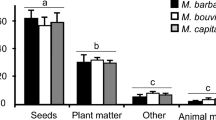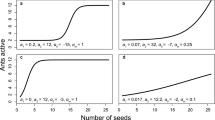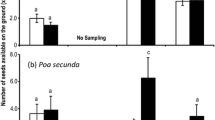Summary
Individual seed harvester ants (Pogonomyrmex) have been shown to specialize on specific seed types. We examined possible mechanisms for seed specialization and tested whether fidelity to food type limits the foraging decisions of individual western harvester ants, Pogonomyrmex occidentalis. The seed selection regimes of individually marked ants foraging at piles of two seed types were described and related to differences in seed quality and colonial dietary history. Individual foraging choices were affected by multiple factors, including seed caloric rewards, the previous seed selected, and the dietary history of the colony. Individual seed choices generally converged on the most energetically profitable species, suggesting that foragers exhibit labile preference. However, for a portion of the foragers, seed specialization was also partially due to constancy, defined as a tendency to select seed species that were previously collected. When colonies were presented with one seed type for 1 h and then were offered a mix of that seed and a novel seed type, individuals showed a strong preference for the novel seeds. Such rapid changes in seed preference argue strongly that individual P. occidentalis ants are highly flexible in seed choice and that resource assessment by these ants is more complex than simple maximization of net energetic return.
Similar content being viewed by others
References
Bateman A (1951) The taxonomic discrimination of bees. Heredity 5:271–278
Breed MD, Fewell JF, Moore AJ, Williams K (1987) Graded recruitment in a ponerine ant. Behav Ecol Sociobiol 20:407–411
Cherrett JM (1972) Chemical aspects of plant attack by leaf-cutting ants. In: Harbourne J (ed) Phytochemical ecology. Academic Press, London, pp 13–24
Darwin C (1876) On the effects of cross and self-fertilization in the vegetable kingdom. Murray, London
Davidson DW (1978) Experimental tests of the optimal diet in two social insects. Behav Ecol Sociobiol 4:35–41
Fewell JH (1988a) Energetic and time costs of foraging in harvester ants, Pogonomyrmex occidentalis. Behav Ecol Sociobiol 22:401–408
Fewell JH (1988b) Variation in the foraging patterns of the ant, Pogonomyrmex occidentalis in relation to variation in habitat structure. In: Jeanne RL (ed) Interindividual behavioral variability in social insects. Westview Press, Boulder CO
Fewell JH (1990) Directional fidelity as a foraging constraint in the harvester ant, Pogonomyrmex occidentalis. Oecologia 82:45–51
Heinrich B (1976) The foraging specializations of individual bumblebees. Ecol Monogr 46:105–128
Heinrich B (1979) ‘Majoring’ and ‘minoring’ by foraging bumblebees, Bombus vagans: an experimental analysis. Ecology 60:245–255
Johnson RA, Rissing SW (1990) Comparative learning and memory of two sympatric seed-harvester ants. In: Veeresh GK, Mallik B, Viraktamath CA (eds) Social insects and the environment. Proc 11th Int Congr IUSSI. Oxford and IBH, Bombay
Kehick MI, MacMahon JA, Parmenter RR, Sisson DV (1986) Native seed preferences of shrub-steppe rodents, birds and ants: the relationships of seed attributes and seed use. Oecologia 68:327–337
Laverty TM (1980) The flower-visiting behaviour of bumblebees: floral complexity and learning. Can J Zool 58:1324–1335
Lewis AC (1986) Memory constraints and flower choice in Pieris rapae. Science 232:863–865
Lewis AC (1989) Flower visit consistency in Pieris rapae, the cabbage butterfly. J Anim Ecol 58:1–13
Littledyke M, Cherrett JM (1975) Variability in the selection of substrate by the leaf-cutting ants Atta cephalotes (L.) and Acromyrmex octospinosus (Reich) (Formicidae, Attini). Bull Entomol Res 65:33–47
Nickel DA, Neal TM (1972) Observations of foraging behavior of southern harvester ants, Pogonomyrmex badius. Fla Entomol 55:65–66
Oster GF, Wilson EO (1978) Caste and ecology in the social insects. Monogr Popul Biol 12. Princeton University Press, Princeton NJ
Paine RT (1971) The measurement and application of the calorie to ecological problems. Annu Rev Ecol Syst 2:145–164
Rissing SW (1981) Foraging specializations of individual seed-harvester ants. Behav Ecol Sociobiol 9:149–152
Rissing SW, Pollock GB (1984) Worker size variability and foraging efficiency in Veromessor pergandei (Hymenoptera: Formicidae). Behav Ecol Sociobiol 15:121–126
Rissing SW, Wheeler J (1976) Foraging responses of Veromessor pergandei to changes in seed production (Hymenoptera: Formicidae). Pan-Pacif Entomol 52:63–72
Scherz H, Kloos G (1981) Food composition and nutrition tables 1981/82 (Deutsche Forschungsanstalt für Lebensmittelchemie). Wissenschaftliche Verlagsgesellschaft, Stuttgart
Schmid-Hempel P (1984) Individually different foraging methods in the desert ant Cataglyphis bicolor (Hymenoptera, Formicidae). Behav Ecol Sociobiol 14:263–271
Sokal RR, Rohlf FJ (1981) Biometry, 2nd edn. Freeman, San Francisco CA
Taylor F (1977) Foraging behavior in ants: experiments with two species of myrmecine ants. Behav Ecol Sociobiol 2:147–168
Traneillo JFA (1987) Individual and social modification of behavior in response to environmental factors in ants. In: Pasteels JM, Deneubourg JL (eds) From individual to collective behavior in social insects. Princeton University Press, Princeton NJ
Traniello JFA (1988) Variation in foraging behavior among workers of the ant Formica schaufussi: ecological correlates of search behavior and the modification of search pattern. In: Jeanne RL (ed) Interindividual behavioral variability in social insects. Westview Press, Boulder CO
Traneillo JFA (1989) Foraging strategies of ants. Annu Rev Entomol 34:191–210
Traniello JFA, Fujita MS, Bowen RV (1984) Ant foraging behavior: ambient temperature influences prey selection. Behav Ecol Sociobiol 15:65–68
Waser NM (1986) Flower constancy: definition, cause, and measurement. Am Nat 127:593–603
Wells H, Wells PH (1983) Honeybee foraging: optimal diet, minimal uncertainty, or individual constancy behaviour? J Anim Ecol 52:829–836
Author information
Authors and Affiliations
Additional information
Offprint requests to: J.H. Fewell at the current address
Rights and permissions
About this article
Cite this article
Fewell, J.H., Harrison, J.F. Flexible seed selection by individual harvester ants, Pogonomyrmex occidentalis . Behav Ecol Sociobiol 28, 377–384 (1991). https://doi.org/10.1007/BF00164118
Received:
Accepted:
Published:
Issue Date:
DOI: https://doi.org/10.1007/BF00164118




